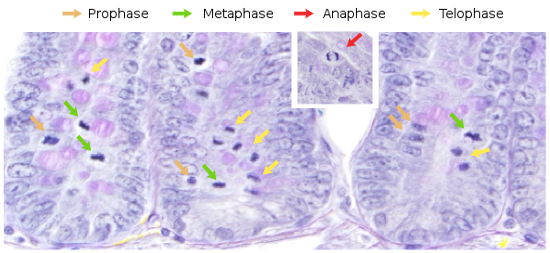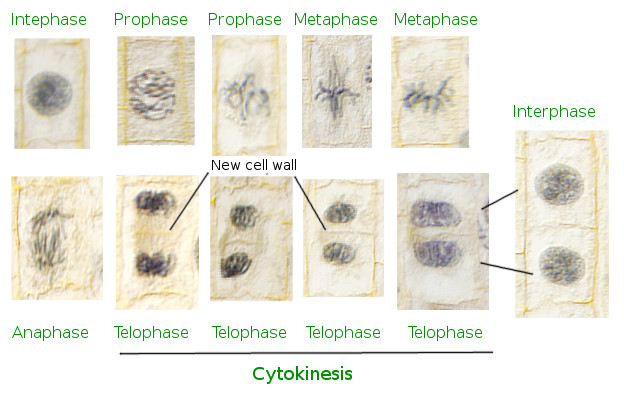The cell cycle is an ordered set of phases in the life of proliferating cells. A cell is "born" after the division of a progenitor cell. Then, the new cell begins the cell cycle phases by growing, replicating its DNA, condensing its DNA and chromosomes, and finally becoming a progenitor cell, which divides to give rise to two new cells. However, there are other possibilities. For example, many cells never divide, such as neurons, and some other special cells are born from the fusion of two cells, such as zygotes (the fusion of two gametes), or by the fusion of many cells, such as skeletal striated muscle cells.
There are two major cell types in multicellular organisms: somatic and germinal cells. Both are able to complete the cell cycle and give rise to somatic or germinal cells, respectively, through a process known as mitosis. By mitosis, somatic cells give other somatic cells, and germinal cells give other germinal cells. However, germinal cells can also give rise to gametes through a process known as meiosis. The distinction between mitosis and meiosis is important because only germinal cells undergo meiosis, that is, the production of four haploid gametes from one diploid germinal cell.
In the next few pages, we will deal with the cell cycle of proliferating somatic cells. It is also shown some examples of cells that do not complete the cell cycle, become long-living cells or die. Cell death may be caused by damages, or it can be a physiological mechanism known as apoptosis.
1. Cell cycle phases
Cell cycle goes through several phases: G1, S, G2 and M (G stands for gap, S for synthesis, and M for mitosis) (Figure 1). This sequence is present in almost every eukaryote proliferating cell, and only occasionally some cell cycle phases are skipped. G1, S, and G2 phases are grouped in a larger phase known as the interphase.

G1 is the first phase after the cell "birth". This is the longest and more variable period of the cell cycle, where the cell grows to reach its optimal size. At the end of the G1 phase, there is a molecular checkpoint that blocks the start of the next phase, the S phase, unless all the requirements needed to carry out a successful S phase are accomplished. For instance, a required cell size or not having DNA damages. Not all the cells of the organism are continuously proliferating. Many cells halt the G1 phase and quit the cell cycle in order to carry out their functions. Some cells may quit the cell cycle for a while and then restart it, or they can stay as differentiated cells forever.
S phase is the DNA synthesis phase. During this phase, the DNA is replicated. This is a complex process because of the long DNA strands that form the eukaryotic genome. The duplication of the DNA must accomplish two requirements: just one copy (one replication round) and making as few mistakes as possible. Any error during the replication of DNA may lead to lethal damages in the two new cells and, what is worse, in the organism.
G2 phase is another period for cell growth, shorter than G1. A variety of molecules that will be necessary during the next phase, the M phase, are synthesyzed during the G2 phase.
M phase is probably the most complex of the cell cycle phases, involving a large reorganization of cellular components. Organelles and other cellular components are distributed in two groups to form the two new daughter cells. In this phase, several molecular processes are triggered and run simultaneously. Mitosis is the process of condensing, segregating and decondensing chromosomes to form the two new nuclei. It can be divided into several stages: prophase, metaphase, anaphase and telophase (Figures 2 and 3). The compaction of DNA happens during prophase, chromosomes are lined up into an equatorial plane during metaphase, chromatids separate during anaphase, and decondensation of DNA and rebuilding the two new nuclei happen during telophase. Other parallel processes are the breakdown of the nuclear envelope, mitotic spindle formation, and the distribution of cytoplasmatic components. Cytokinesis begins during the later stages of mitosis. Cytokinesis is the mechanism of splitting the mother cytoplasm in two. In animal cells, an actin filament ring strangles the cytoplasm and separates the two new cells. In plant cell cytokinesis, a new cell wall that divides the cytoplasm in two is synthesized. M phase ends up with two new cell,s and G1 phase starts again.


2. Variability
The cell cycle has to be tightly controlled and coordinated in the many cell types that form the tissues and organs. For instance, what is the speed for tissue repairing, for replacing blood cells, or for the growth rate of the plant stem and root? The frequency of cell cycles and the time they last are variable among the cell types, and they determine the production of new cells. During embryonic development and juvenile periods, many cell types contribute to animal growth, meaning a high cell cycle frequency. However, once the adult size is reached, many cell populations stop or lower the proliferation rate to balance the maintaining of the tissue, and sometimes to repairing damages. Occasionally, errors in the DNA allow cells to skip the cell cycle regulation, and they proliferate out of control. They are the cancer cells.
The length of the cell cycle, that is, how much time it takes from the moment a cell appears until it divides, determines the speed at which a cell population increases its cell number. The cell cycle length varies between species and between cell types in an organism. For instance, the fruit fly embryo shows a cell cycle length of about 8 minutes (G1 and G2 phases are lacking), whereas it can be about a year for mammal hepatocytes, because they can temporarily abandon the cell cycle. On average, the cell cycle in mammal cells is about 24 hours.
Another feature of the cell cycle is how long each of the phases lasts. This particular length is also variable between species and cell types (Figure 4). In mammalian proliferating cells, about half of the cell cycle is spent in the G1 phase, and nearly the other half in the S phase, whereas the M and G2 phases are very short. The most variable phase of the cell cycle is the G1 phase, while the S phase is rather constant between cell types.

It is interesting that the cell cycle follows the circadian rhythm in many species. This rhythm is influenced by the internal clocks of the cells, which appears to be present in every cell, including prokaryotes. For instance, it happens in cell cultures of eukaryotes. The circadian clock is controlled by activators and inhibitors of the transcription factors that oscillate.
 Intermediate filaments
Intermediate filaments